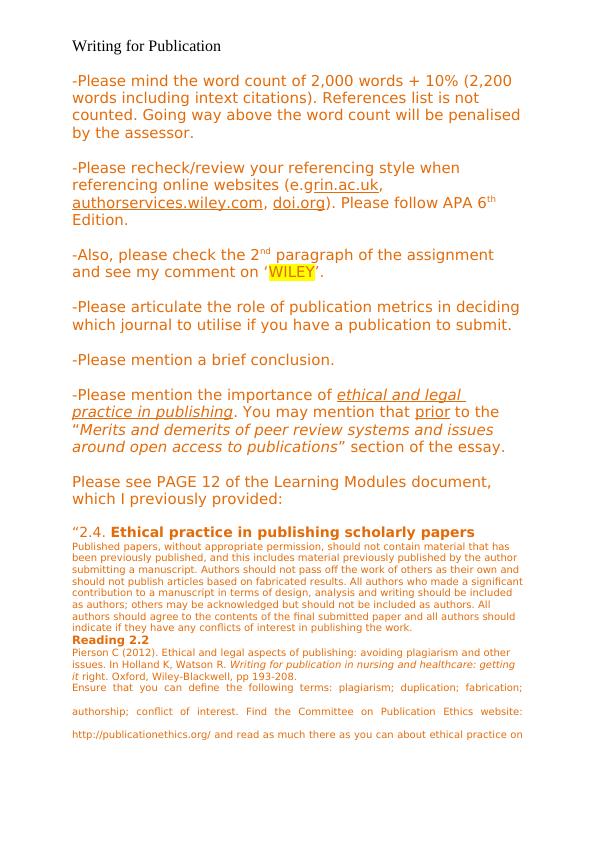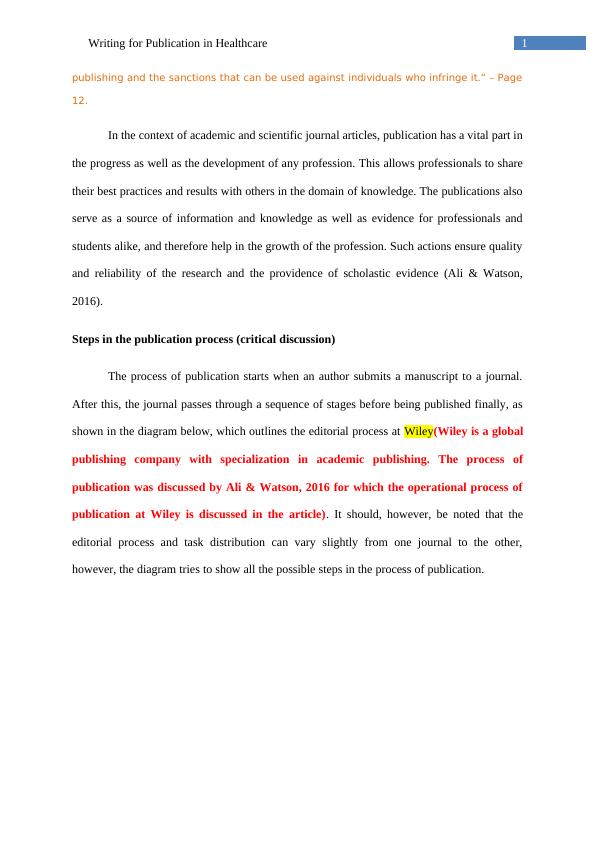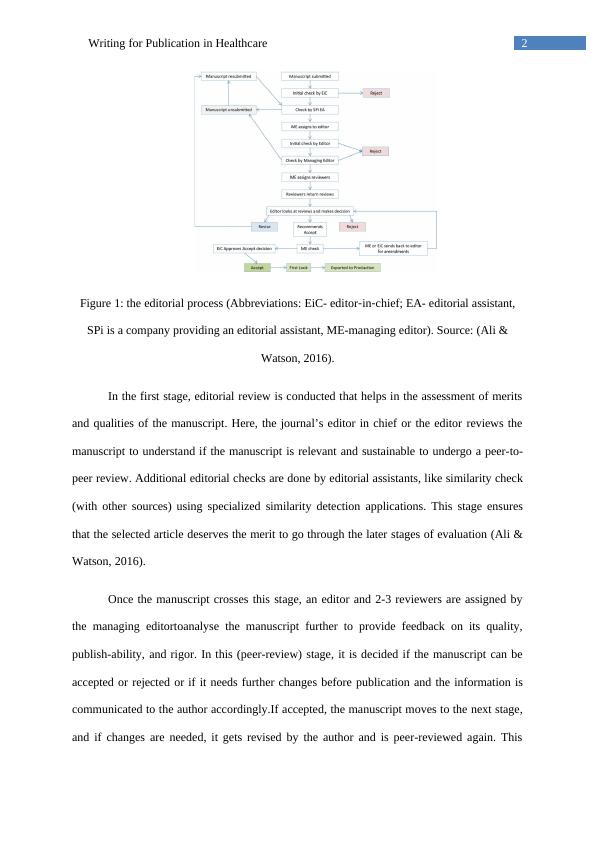Writing for Publication in Healthcare
Added on 2021-04-24
12 Pages3333 Words280 Views
Writing for Publication-Please mind the word count of 2,000 words + 10% (2,200 words including intext citations). References list is not counted. Going way above the word count will be penalisedby the assessor. -Please recheck/review your referencing style when referencing online websites (e.grin.ac.uk, authorservices.wiley.com, doi.org). Please follow APA 6thEdition. -Also, please check the 2nd paragraph of the assignment and see my comment on ‘WILEY’.-Please articulate the role of publication metrics in decidingwhich journal to utilise if you have a publication to submit. -Please mention a brief conclusion. -Please mention the importance of ethical and legal practice in publishing. You may mention that prior to the “Merits and demerits of peer review systems and issues around open access to publications” section of the essay.Please see PAGE 12 of the Learning Modules document, which I previously provided:“2.4. Ethical practice in publishing scholarly papers Published papers, without appropriate permission, should not contain material that has been previously published, and this includes material previously published by the author submitting a manuscript. Authors should not pass off the work of others as their own and should not publish articles based on fabricated results. All authors who made a significantcontribution to a manuscript in terms of design, analysis and writing should be included as authors; others may be acknowledged but should not be included as authors. All authors should agree to the contents of the final submitted paper and all authors should indicate if they have any conflicts of interest in publishing the work. Reading 2.2 Pierson C (2012). Ethical and legal aspects of publishing: avoiding plagiarism and other issues. In Holland K, Watson R. Writing for publication in nursing and healthcare: getting it right. Oxford, Wiley-Blackwell, pp 193-208. Ensure that you can define the following terms: plagiarism; duplication; fabrication;authorship; conflict of interest. Find the Committee on Publication Ethics website:http://publicationethics.org/ and read as much there as you can about ethical practice on

1Writing for Publication in Healthcarepublishing and the sanctions that can be used against individuals who infringe it.“ – Page12. In the context of academic and scientific journal articles, publication has a vital part inthe progress as well as the development of any profession. This allows professionals to sharetheir best practices and results with others in the domain of knowledge. The publications alsoserve as a source of information and knowledge as well as evidence for professionals andstudents alike, and therefore help in the growth of the profession. Such actions ensure qualityand reliability of the research and the providence of scholastic evidence (Ali & Watson,2016).Steps in the publication process (critical discussion) The process of publication starts when an author submits a manuscript to a journal.After this, the journal passes through a sequence of stages before being published finally, asshown in the diagram below, which outlines the editorial process at Wiley(Wiley is a globalpublishing company with specialization in academic publishing. The process ofpublication was discussed by Ali & Watson, 2016 for which the operational process ofpublication at Wiley is discussed in the article). It should, however, be noted that theeditorial process and task distribution can vary slightly from one journal to the other,however, the diagram tries to show all the possible steps in the process of publication.

2Writing for Publication in HealthcareFigure 1: the editorial process (Abbreviations: EiC- editor‐in‐chief; EA- editorial assistant,SPi is a company providing an editorial assistant, ME-managing editor). Source: (Ali &Watson, 2016). In the first stage, editorial review is conducted that helps in the assessment of meritsand qualities of the manuscript. Here, the journal’s editor in chief or the editor reviews themanuscript to understand if the manuscript is relevant and sustainable to undergo a peer-to-peer review. Additional editorial checks are done by editorial assistants, like similarity check(with other sources) using specialized similarity detection applications. This stage ensuresthat the selected article deserves the merit to go through the later stages of evaluation (Ali &Watson, 2016).Once the manuscript crosses this stage, an editor and 2-3 reviewers are assigned bythe managing editortoanalyse the manuscript further to provide feedback on its quality,publish-ability, and rigor. In this (peer-review) stage, it is decided if the manuscript can beaccepted or rejected or if it needs further changes before publication and the information iscommunicated to the author accordingly.If accepted, the manuscript moves to the next stage,and if changes are needed, it gets revised by the author and is peer-reviewed again. This

3Writing for Publication in Healthcareensures a thorough analysis by subject matter experts, before being validated (Jacobsen et al.,2017).After this stage, it moves on to stage three, which is production. At this stage, it isensured that the article produced is readable, comprehensible and free of spelling mistakes,and maintains adherence to the presentation style acceptable by the journal. After a check andapproval of the final draft by the author, the manuscript moves to the final stage, theadministrative process. During this stage, proper tracking number known as the DigitalObject Identifier (DOI) is allocated to the academic/scientific literature. The last 2 stepsensure the article is made available in electronic and print media (doi.org, 2018).The types of peer review that can be conducted for the academic manuscripts/articlescan include closed peer review, open peer review, post-publication peer review, single blindor double-blind review (authorservices.wiley.com, 2018).Purpose of quality assurance in publication process (importance of QA) Quality assessment/assurance plays a crucial role in the research community as theyinform important decisions related to funding, research, recruitment, promotion of theresearch and how its findings are presented. They help to establish the reliability of a researchwork (reading.ac.uk, 2018).The QA techniques systems have evolved in response to severalfactors like increase in research volume, increased stress on costs, competition betweenresearchers and new types of research outputs (Ali & Watson, 2016).The process is aimed to ensure that the research studies are being properly conductedwith effectiveness and efficiency, and when completed, the results of the study arepresentable and maintain a high standard. This also ensures that the research information orrecords, also known as ‘minutes of science’ provides results with great accuracy. Quality

End of preview
Want to access all the pages? Upload your documents or become a member.
Related Documents
(PDF) Writing for publicationlg...
|13
|3638
|29
Measurement Techniques for Business Performance | Bank of Maldiveslg...
|19
|5746
|1
4UDBE - Dynamic Business Environmentslg...
|19
|5317
|541
5UEFM Level 5 Effective Financial Managementlg...
|22
|5908
|1273
5UIBP Level 5 Innovation and Business Performancelg...
|15
|5404
|866
Extent of Plagiarism in UK Universitieslg...
|7
|2249
|409
